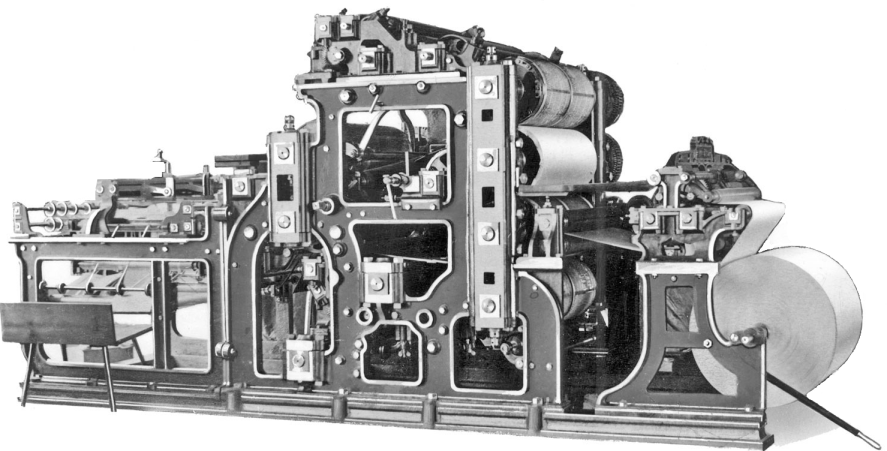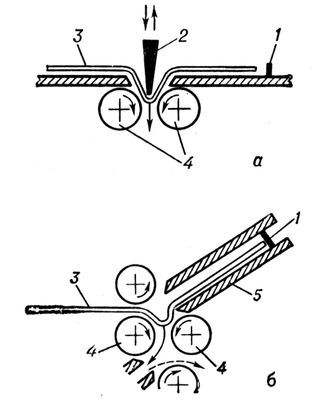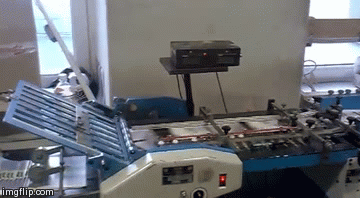Printing machines. The power and support of printing
Good day, Habr.
The press surrounds us and permeates all spheres of human life. But has it always been that printing was so simple and ordinary? Not at all. Have old aggregates disappeared from our lives? Also no. Something archaic surrounds us to this day, although it was wrapped in modern technology and robotic lines, but the fundamental principles of the design of printing machines do not change. I am talking about printing in its classic, pristine form. Want to learn a little more about how your favorite magazines or free newspapers clogging your mailbox are created? The world of printing presses is much more diverse than you might expect.
In order to unload the material even more and make it even less academic, I reworked the publication. Now it is clearer and more interesting, forgive editors-technologists. Have a good reading.

First Magdeburger Zeitung Web Press
Each of us at school heard about first-printers in the territory of our country. For Russia it’s Ivan Fedorov, for Belarus it’s Francis Skarin, but the name of Johannes Gutenberg , a jeweler and inventor who lived in the 15th century, will forever remain in world history . Gutenberg's contribution as an inventor to the development of our civilization is difficult to overestimate. Presenting the world with such a thing as a printing press based on technology of mobile letters, this man from the urban Burger estate made it possible to carry more effectively, now not a handwritten, but a printed word to the masses.
What is typing? In fact, this is a process that allows you to get a given number of copies with specified parameters with minimal differences between copies from each other. Professional literature gives us the following definition:
Printing is the repeated receipt of identical images with specified quality parameters.
In industrial printing, specifically in the method discussed in this article, so-called forms are still used, if you like matrices. During printing, ink is applied to the forms and transferred from it to the printed material. Professionals printed in this way are called a print .
So that there would be no disputes and debate on the topic of who is doing what, the technologists have clearly defined what combination of actions and signs constitutes printing:
The printing process itself cannot occur without the participation of ink, and it does not cause irreversible deformation of the material on which the ink is applied. Each of us, reading a brand new book, noticed that if you swipe the finger hard, they are smeared. This is normal because the paint does not impregnate the paper but is applied in a thin layer on top of it. I will tell you about the procedure for applying ink using shaped rollers below, but for now let's move on to definitions describing the methods of applying ink to paper that determine the technology, characteristics and quality of the printed impression.
In the previous edition of the article, theycrucified me reproached in the comments for not revealing the essence of the mentioned methods. Specifically, in this material we will consider direct printing methods using forms. Offset and inkjet printing, if you allow me, will receive separate articles, since they are more modern and more complicated technologies, which are not meaningful to describe in a nutshell.
This type of printing machine is the most archaic at the moment, but allows you to get the most complete picture of the classical printing of such things as newspapers, notebooks, books.
A roll rotary printing machine (hereinafter referred to as the RRP machine or simply RRP) is a food processor in the printing world. These units have the broadest possibilities. RRS can not only print, but also fold , select , cut and even stitch products made with wire. Also, rotary machines are the first in such a parameter as print speed. Some of them can produce up to ~ 350 sheets per minute (about 21,000 sheets per hour).
It is interesting to note that if you have an average reading speed of 200 words per minute for a person, then from the moment you started reading the article to this proposal, the RP machine could print more than a thousand sheets of text . Most likely because of their productivity, they are so common for printing newspapers and books, where a large circulation is needed.


In the course of work, paper is fed from the roll indicated on the diagram under No. 1. More complex RP devices are not limited to one roll and can work with several at once. Printing can be either single-sided or double-sided, as in our case. After starting, the paper is fed through a system of rollers to the printing devices shown in the diagram under No. 2 and No. 3. Each of them imprints its side of the sheet.
The machine we are considering can have two different types of printing:
For printing newspapers and ordinary books, letterpress is used, and for magazines, gravure is used. Differences Between the mentioned types of prints I will now explain below.

In the course of work, a paint labeled No. 2 is applied to the printing plate under No. 1. The form is pressed against the paper under pressure, which leads to tight contact between them. At the moment of contact, part of the ink adheres to the paper and after scrolling the form on the printed material, it remains, ink, a thin layer.

Getting an intaglio print is getting harder. The main feature is the application of ink to the entire printing form, followed by its removal with a squeegee from the blanks and partially from the printing elements, i.e. in fact, the paint is poured into special cells on the form, and not applied to the protruding parts as in the case of high printing. A squeegee is such an elastic flat steel knife with a thickness of 0.15-0.20 mm, the length of which is greater than the length of the plate cylinder. When the form scrolls on paper, some of the paint from the cells sticks and stays on it. The layer thickness, depending on the required tonality of the image, ranges from 0.2–0.3 to 4.5–5.0 μm.
After printing and, if necessary, slicing, the sheet enters the folding machine shown in the diagram under No. 6. Folding apparatus is a device that bends the supplied sheets for further sorting, pressing or processing, if the cut material is a semi-finished product , in pressing device No. 7.
Folding machines can also be different based on the principle of their work.


In the knife machines, sheet No. 3 in the diagram is inserted between the rollers at No. 4 by the impact of a blunt knife at No. 2.
In cassette devices, the leading edge of the feed sheet under No. 3 abuts against the bar of cartridge No. 1, forming a loop, the edges of which are captured by folding rollers No. 4. In operation, the cassette folding machine looks like this:

There are also combined versions of the folding machine. The first, parallel bends in them are made using cassettes, and perpendicular - with knives. The folding machine may also include additional functions: gluing the roots, stapling sheets with wire staples, perforation, etc.
All of those described above. the process occurs, as can be seen from the gif animation above, at tremendous speeds and with amazing accuracy. Something like this still prints newspapers, magazines, notebooks and books.
By the way, for the average reading time of the article, the same RP machine would print almost 2,200 sheets . Here it is.
With respect.
PS In this material I tried to describe in a general and accessible way the technical process that occurs in printing houses around the world when printing, professional literature on this subject can damage my consciousness. Mine, for example, cannot be saved anymore (: If you liked the article, in the following publications I will be able, as promised, to talk about offset printing, as well as many, many other things that are no less interesting from the point of view of the implementation and depth of the technical thought of engineers and technologists.
The press surrounds us and permeates all spheres of human life. But has it always been that printing was so simple and ordinary? Not at all. Have old aggregates disappeared from our lives? Also no. Something archaic surrounds us to this day, although it was wrapped in modern technology and robotic lines, but the fundamental principles of the design of printing machines do not change. I am talking about printing in its classic, pristine form. Want to learn a little more about how your favorite magazines or free newspapers clogging your mailbox are created? The world of printing presses is much more diverse than you might expect.
In order to unload the material even more and make it even less academic, I reworked the publication. Now it is clearer and more interesting, forgive editors-technologists. Have a good reading.

First Magdeburger Zeitung Web Press
Introduction
Each of us at school heard about first-printers in the territory of our country. For Russia it’s Ivan Fedorov, for Belarus it’s Francis Skarin, but the name of Johannes Gutenberg , a jeweler and inventor who lived in the 15th century, will forever remain in world history . Gutenberg's contribution as an inventor to the development of our civilization is difficult to overestimate. Presenting the world with such a thing as a printing press based on technology of mobile letters, this man from the urban Burger estate made it possible to carry more effectively, now not a handwritten, but a printed word to the masses.
Generalized scheme of the printing process
What is typing? In fact, this is a process that allows you to get a given number of copies with specified parameters with minimal differences between copies from each other. Professional literature gives us the following definition:
Printing is the repeated receipt of identical images with specified quality parameters.
In industrial printing, specifically in the method discussed in this article, so-called forms are still used, if you like matrices. During printing, ink is applied to the forms and transferred from it to the printed material. Professionals printed in this way are called a print .
The main features of the printing process:
So that there would be no disputes and debate on the topic of who is doing what, the technologists have clearly defined what combination of actions and signs constitutes printing:
- Transfer of ink to the material using a printing plate with subsequent fixing;
- Repeated receipt of prints and their identity, i.e. the possibility of creating a circulation .
The printing process itself cannot occur without the participation of ink, and it does not cause irreversible deformation of the material on which the ink is applied. Each of us, reading a brand new book, noticed that if you swipe the finger hard, they are smeared. This is normal because the paint does not impregnate the paper but is applied in a thin layer on top of it. I will tell you about the procedure for applying ink using shaped rollers below, but for now let's move on to definitions describing the methods of applying ink to paper that determine the technology, characteristics and quality of the printed impression.
Methods of transferring ink to the printed material:
- direct (contact)
- indirect (contact offset)
- contactless (inkjet printing)
In the previous edition of the article, they
The device and operation of a roll rotary printing machine
This type of printing machine is the most archaic at the moment, but allows you to get the most complete picture of the classical printing of such things as newspapers, notebooks, books.
A roll rotary printing machine (hereinafter referred to as the RRP machine or simply RRP) is a food processor in the printing world. These units have the broadest possibilities. RRS can not only print, but also fold , select , cut and even stitch products made with wire. Also, rotary machines are the first in such a parameter as print speed. Some of them can produce up to ~ 350 sheets per minute (about 21,000 sheets per hour).
It is interesting to note that if you have an average reading speed of 200 words per minute for a person, then from the moment you started reading the article to this proposal, the RP machine could print more than a thousand sheets of text . Most likely because of their productivity, they are so common for printing newspapers and books, where a large circulation is needed.


In the course of work, paper is fed from the roll indicated on the diagram under No. 1. More complex RP devices are not limited to one roll and can work with several at once. Printing can be either single-sided or double-sided, as in our case. After starting, the paper is fed through a system of rollers to the printing devices shown in the diagram under No. 2 and No. 3. Each of them imprints its side of the sheet.
The machine we are considering can have two different types of printing:
- Letterpress
- Gravure printing
For printing newspapers and ordinary books, letterpress is used, and for magazines, gravure is used. Differences Between the mentioned types of prints I will now explain below.

In the course of work, a paint labeled No. 2 is applied to the printing plate under No. 1. The form is pressed against the paper under pressure, which leads to tight contact between them. At the moment of contact, part of the ink adheres to the paper and after scrolling the form on the printed material, it remains, ink, a thin layer.

Getting an intaglio print is getting harder. The main feature is the application of ink to the entire printing form, followed by its removal with a squeegee from the blanks and partially from the printing elements, i.e. in fact, the paint is poured into special cells on the form, and not applied to the protruding parts as in the case of high printing. A squeegee is such an elastic flat steel knife with a thickness of 0.15-0.20 mm, the length of which is greater than the length of the plate cylinder. When the form scrolls on paper, some of the paint from the cells sticks and stays on it. The layer thickness, depending on the required tonality of the image, ranges from 0.2–0.3 to 4.5–5.0 μm.
After printing and, if necessary, slicing, the sheet enters the folding machine shown in the diagram under No. 6. Folding apparatus is a device that bends the supplied sheets for further sorting, pressing or processing, if the cut material is a semi-finished product , in pressing device No. 7.
Folding machines can also be different based on the principle of their work.


In the knife machines, sheet No. 3 in the diagram is inserted between the rollers at No. 4 by the impact of a blunt knife at No. 2.
In cassette devices, the leading edge of the feed sheet under No. 3 abuts against the bar of cartridge No. 1, forming a loop, the edges of which are captured by folding rollers No. 4. In operation, the cassette folding machine looks like this:

There are also combined versions of the folding machine. The first, parallel bends in them are made using cassettes, and perpendicular - with knives. The folding machine may also include additional functions: gluing the roots, stapling sheets with wire staples, perforation, etc.
All of those described above. the process occurs, as can be seen from the gif animation above, at tremendous speeds and with amazing accuracy. Something like this still prints newspapers, magazines, notebooks and books.
By the way, for the average reading time of the article, the same RP machine would print almost 2,200 sheets . Here it is.
With respect.
PS In this material I tried to describe in a general and accessible way the technical process that occurs in printing houses around the world when printing, professional literature on this subject can damage my consciousness. Mine, for example, cannot be saved anymore (: If you liked the article, in the following publications I will be able, as promised, to talk about offset printing, as well as many, many other things that are no less interesting from the point of view of the implementation and depth of the technical thought of engineers and technologists.
PSS In order to better understand the preferences of the community I screwed the vote. Determine for yourself what you want to read, if at all.
Only registered users can participate in the survey. Please come in.
Continue?
- 94.1% Yes. 307
- 2.7% None. 9
- 3% I have not read, but I condemn! 10
What would you like to know in more detail?
- 29.4% promised offset printing - tell me. 96
- 6.4% More Chemistry! What kind of paint, paper, how do they interact, etc. 21
- 23.6% More Mechanics! Differences between various types of printing presses, device drives, etc. 77
- 38% It does not matter, the whole topic is interesting. 124
- 2.4% I prefer to argue about fonts for caps of online stores, rather than reading about some remnants of the past 8
